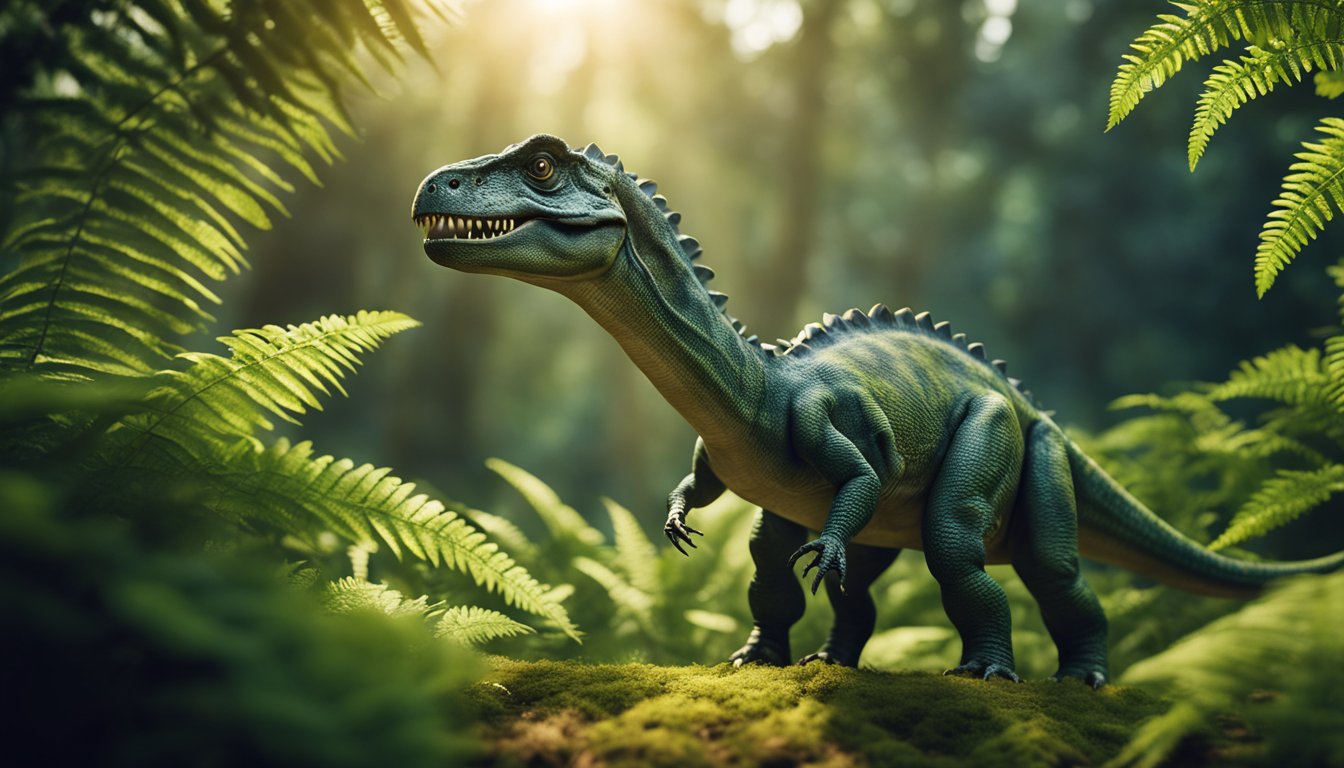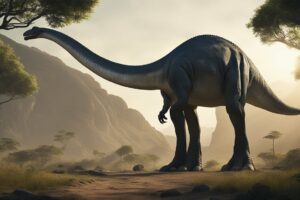Meganeura, the giant dragonflies of prehistoric times, were some of the largest insects to ever roam the Earth.
These fascinating creatures lived during the Carboniferous period, over 300 million years ago, and were known for their impressive size and elongated body shape.
With a wingspan of up to 75 centimeters, Meganeura was an awe-inspiring sight to behold and is still a source of wonder for scientists and nature enthusiasts today.

Despite their intimidating appearance, Meganeura were not harmful to humans.
In fact, they were harmless herbivores that fed on other insects and small animals.
Their size and agility gave them an advantage over other creatures, allowing them to fly with ease and escape predators.
Meganeura’s wings were also unique, with a complex network of veins that allowed for greater maneuverability and control in flight.
These ancient insects were a testament to the incredible diversity and adaptability of life on Earth, and continue to inspire curiosity and amazement in people of all ages.
Unveiling the Meganeura
Meganeura, the giant prehistoric dragonfly, is a fascinating creature that roamed the earth during the Carboniferous period, about 300 million years ago.
The discovery of its fossils has provided valuable insights into the evolution of insects and the natural history of our planet.
Discovering the Fossils
The first Meganeura fossils were discovered in France in 1880 by Charles Brongniart, a French paleontologist.
The fossils were found in coal deposits, which preserved the delicate wings and body structures of these ancient insects.
Since then, Meganeura fossils have been found in various parts of the world, including North America, Europe, and Asia.
These fossils have helped scientists to reconstruct the anatomy and behavior of these giant dragonflies.
Defining Characteristics
Meganeura belonged to the Meganeuridae family, which is related to modern-day dragonflies.
However, Meganeura was much larger than any living dragonfly, with a wingspan of up to 75 centimeters.
One of the defining characteristics of Meganeura was its large and elongated body shape, which was supported by a strong exoskeleton.
Its wings were also very large and had a complex network of veins, which allowed for efficient flight.
Meganeura was a predator, feeding on other insects and small animals. Its large size and powerful jaws made it a formidable hunter in its time.
Fun fact: Meganeura Monyi is one of the largest known species of flying insects, with a wingspan of over 70 centimeters.
In conclusion, Meganeura is a remarkable creature that has captured the imagination of scientists and the public alike.
Its fossils have provided valuable insights into the natural history of our planet and the evolution of insects.
The World of Giant Insects

During the Carboniferous period, the world was a very different place.
The atmosphere was rich in oxygen, which allowed for the growth of giant insects like Meganeura.
These prehistoric dragonflies roamed the skies with wingspans of up to 2.5 feet, making them the largest insects to ever exist.
Carboniferous Period Atmosphere
The Carboniferous period was characterized by a warm and humid climate, with vast swamps and forests covering the land.
The atmosphere was also very different from what we have today, with oxygen levels reaching up to 35%, compared to the current 21%.
This high oxygen concentration allowed insects to grow to enormous sizes, as oxygen is needed to fuel their metabolism.
Predators and Prey
Meganeura was a fierce predator, swooping down from the skies to capture its prey.
Its large eyes allowed it to spot prey from a distance, while its sharp mandibles made quick work of its victims.
Meganeura likely fed on other insects and small animals, such as amphibians and reptiles.
However, Meganeura was not the only predator in the Carboniferous period.
Other giant insects, such as the centipede-like Arthropleura, roamed the forest floor, while amphibians and reptiles lurked in the swamps.
Extinction Events
Despite their dominance during the Carboniferous period, giant insects like Meganeura eventually went extinct.
The exact cause of their extinction is still unknown, but it is believed to be linked to a series of extinction events that occurred during the late Carboniferous and early Permian periods.
These events may have been caused by a combination of factors, such as climate change, volcanic activity, and the emergence of new predators.
Today, the world is very different from the Carboniferous period, and insects have adapted to the changing environment.
While we may never see giant dragonflies like Meganeura again, we can still marvel at their incredible size and imagine what it must have been like to live in a world of giant insects.
Anatomy and Abilities

Meganeura, the giant prehistoric dragonfly, was a fascinating creature with a unique anatomy and exceptional abilities.
Here are some of the most notable features of this remarkable insect.
Extraordinary Wingspan
Meganeura had a wingspan of up to 75 cm, making it one of the largest insects that ever lived.
Its wings were incredibly strong and flexible, allowing it to fly through the air with great speed and agility.
Meganeura’s wings were also covered in tiny scales that helped it to maintain its balance and maneuver in mid-air.
Exceptional Vision
Meganeura had large compound eyes that gave it exceptional vision.
Its eyes were made up of thousands of tiny lenses that allowed it to see in all directions at once.
This gave Meganeura a significant advantage when it came to hunting and avoiding predators.
Hunting and Diet
Meganeura was a predator that fed on other insects, including smaller dragonflies.
Its mandibles were sharp and powerful, allowing it to capture and crush its prey with ease. Meganeura’s hunting strategy was simple but effective.
It would fly above its prey and then swoop down to capture it in mid-air.
Meganeura’s diet was not limited to insects, as some scientists believe that it may have also fed on small vertebrates like fish and tadpoles.
Its hunting skills and ability to adapt to different food sources made it a dominant predator in the Carboniferous period.
Overall, Meganeura was a fascinating creature with unique abilities that allowed it to thrive in its prehistoric environment.
Its extraordinary wingspan, exceptional vision, and predatory skills made it one of the most successful insects of all time.
Meganeura’s Legacy

Meganeura was a giant dragonfly that lived during the Carboniferous period, approximately 300 million years ago.
Despite its extinction, Meganeura’s legacy continues to inspire scientists and researchers to this day.
Its discovery and study have provided valuable insights into the evolution of insects and their biology.
Modern-day dragonflies are one of the closest living relatives of Meganeura.
Scientists have used this relationship to study the morphology and biology of ancient insects.
By comparing the wingspan and body size of Meganeura to modern-day dragonflies, researchers have been able to estimate the atmospheric oxygen levels during the Carboniferous period.
It is believed that the high oxygen levels during that time period allowed insects to grow to such enormous sizes.
Meganeura’s morphology has also been used to study the evolution of insect flight.
Its large wingspan and elongated body shape suggest that Meganeura was a powerful flier.
Researchers have studied the structure of Meganeura’s wings and compared them to modern-day dragonflies to better understand the evolution of insect flight.
In addition to its scientific legacy, Meganeura has captured the imaginations of people around the world.
Its giant size and impressive wingspan make it a fascinating subject for artists and writers.
Meganeura has been featured in numerous works of fiction, from novels to movies.
Overall, Meganeura’s legacy has had a significant impact on the study of insects and their evolution.
Its discovery and study have provided valuable insights into the biology and morphology of ancient insects, as well as the evolution of insect flight.
Meganeura continues to inspire scientists, researchers, and artists alike, and its impact on our understanding of the natural world is undeniable.
Frequently Asked Questions

How large could Meganeura grow during the Carboniferous period?
Meganeura was one of the largest insects to ever exist, with a wingspan that could reach up to 75 centimeters [1].
This is roughly the size of a large seagull or small hawk!
What factors contributed to the enormous size of prehistoric insects like Meganeura?
During the Carboniferous period, the Earth’s atmosphere had a much higher concentration of oxygen than it does today.
This allowed insects like Meganeura to grow much larger than their modern-day counterparts [1].
In what era did Meganeura exist, and did it overlap with the time of the dinosaurs?
Meganeura lived during the Carboniferous period, which lasted from about 359 to 299 million years ago [1].
This was long before the time of the dinosaurs, which did not appear until about 230 million years ago.
What do we know about the diet and hunting habits of Meganeura?
Meganeura was a carnivorous insect, and it likely fed on other insects and small animals [4].
Scientists believe that Meganeura hunted in a similar way to modern-day dragonflies, flying through the air and snatching up prey with its strong jaws [4].
How have scientists been able to reconstruct the appearance and behavior of Meganeura from fossils?
Scientists have been able to learn a lot about Meganeura from fossils, including its size, shape, and even its behavior.
By studying the fossils of other insects from the same time period, scientists have been able to make educated guesses about how Meganeura may have lived [3].
What eventually led to the extinction of giant insects such as Meganeura?
There is still some debate among scientists about what led to the extinction of giant insects like Meganeura.
Some theories suggest that changes in the Earth’s atmosphere, climate, or vegetation may have played a role [5].
Others believe that the evolution of new predators or competitors may have been a factor [5].
Regardless of the cause, it is clear that giant insects like Meganeura disappeared from the Earth’s ecosystems millions of years ago, leaving behind only fossils as a reminder of their once-mighty presence.
Fun fact: Did you know that Meganeura was not actually a dragonfly, but a related group of insects called griffinflies?
These insects had some key differences from dragonflies, including their larger size and different wing structure [1].
[1] http://www.prehistoric-wildlife.com/species/m/meganeura.html [3] https://www.livescience.com/60004-meganeura-giant-dragonfly.html [4] https://peaceofanimals.com/meganeura/ [5] https://www.nationalgeographic.com/science/article/140116-why-did-giant-insects-rule-the-prehistoric-skies





